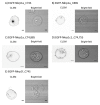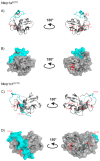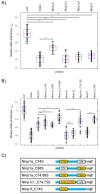Oligomeric Architecture of Mouse Activating Nkrp1 Receptors on Living Cells
- PMID: 30995786
- PMCID: PMC6515139
- DOI: 10.3390/ijms20081884
Oligomeric Architecture of Mouse Activating Nkrp1 Receptors on Living Cells
Abstract
Mouse activating Nkrp1 proteins are commonly described as type II transmembrane receptors with disulfide-linked homodimeric structure. Their function and the manner in which Nkrp1 proteins of mouse strain (C57BL/6) oligomerize are still poorly understood. To assess the oligomerization state of Nkrp1 proteins, mouse activating EGFP-Nkrp1s were expressed in mammalian lymphoid cells and their oligomerization evaluated by Förster resonance energy transfer (FRET). Alternatively, Nkrp1s oligomers were detected by Western blotting to specify the ratio between monomeric and dimeric forms. We also performed structural characterization of recombinant ectodomains of activating Nkrp1 receptors. Nkrp1 isoforms c1, c2 and f were expressed prevalently as homodimers, whereas the Nkrp1a displays larger proportion of monomers on the cell surface. Cysteine-to-serine mutants revealed the importance of all stalk cysteines for protein dimerization in living cells with a major influence of cysteine at position 74 in two Nkrp1 protein isoforms. Our results represent a new insight into the oligomerization of Nkrp1 receptors on lymphoid cells, which will help to determine their function.
Keywords: Förster resonance energy transfer; Nkrp1; cysteine; dimerization; disulfide bond arrangement.
Conflict of interest statement
The authors declare no conflict of interest.
Figures









Similar articles
-
The C-type lectin-like receptor Nkrp1b: Structural proteomics reveals features affecting protein conformation and interactions.J Proteomics. 2019 Mar 30;196:162-172. doi: 10.1016/j.jprot.2018.11.007. Epub 2018 Nov 8. J Proteomics. 2019. PMID: 30414947
-
Analysis of a 1-Mb BAC contig overlapping the mouse Nkrp1 cluster of genes: cloning of three new Nkrp1 members, Nkrp1d, Nkrp1e, and Nkrp1f.Immunogenetics. 2001 Sep;53(7):592-8. doi: 10.1007/s002510100367. Immunogenetics. 2001. PMID: 11685472
-
Analysis of the mouse 129-strain Nkrp1-Clr gene cluster reveals conservation of genomic organization and functional receptor-ligand interactions despite significant allelic polymorphism.Immunogenetics. 2011 Oct;63(10):627-40. doi: 10.1007/s00251-011-0542-8. Epub 2011 Jun 11. Immunogenetics. 2011. PMID: 21667046
-
Modulation of NK cell function by genetically coupled C-type lectin-like receptor/ligand pairs encoded in the human natural killer gene complex.Front Immunol. 2013 Nov 7;4:362. doi: 10.3389/fimmu.2013.00362. Front Immunol. 2013. PMID: 24223577 Free PMC article. Review.
-
Physiologic functions of activating natural killer (NK) complex-encoded receptors on NK cells.Immunol Rev. 2001 Jun;181:126-37. doi: 10.1034/j.1600-065x.2001.1810110.x. Immunol Rev. 2001. PMID: 11513134 Review.
Cited by
-
The biophysical basis of receptor tyrosine kinase ligand functional selectivity: Trk-B case study.Biochem J. 2020 Dec 11;477(23):4515-4526. doi: 10.1042/BCJ20200671. Biochem J. 2020. PMID: 33094812 Free PMC article.
-
Probing Membrane Protein Association Using Concentration-Dependent Number and Brightness.Angew Chem Int Ed Engl. 2021 Mar 15;60(12):6503-6508. doi: 10.1002/anie.202010049. Epub 2021 Feb 4. Angew Chem Int Ed Engl. 2021. PMID: 33351993 Free PMC article.
-
Quantitative characterization of tetraspanin 8 homointeractions in the plasma membrane.Biochem J. 2021 Oct 15;478(19):3643-3654. doi: 10.1042/BCJ20210459. Biochem J. 2021. PMID: 34524408 Free PMC article.
-
The Biased Ligands NGF and NT-3 Differentially Stabilize Trk-A Dimers.Biophys J. 2021 Jan 5;120(1):55-63. doi: 10.1016/j.bpj.2020.11.2262. Epub 2020 Dec 5. Biophys J. 2021. PMID: 33285113 Free PMC article.
-
Interactions between Ligand-Bound EGFR and VEGFR2.J Mol Biol. 2021 Jun 25;433(13):167006. doi: 10.1016/j.jmb.2021.167006. Epub 2021 Apr 20. J Mol Biol. 2021. PMID: 33891904 Free PMC article.
References
-
- Giorda R., Trucco M. Mouse NKR-P1. A family of genes selectively coexpressed in adherent lymphokine-activated killer cells. J. Immunol. 1991;147:1701–1708. - PubMed
MeSH terms
Substances
Grants and funding
LinkOut - more resources
Full Text Sources
Molecular Biology Databases
Miscellaneous

